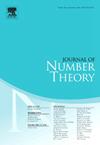两个平方和与其固有子形式的分离
IF 0.6
3区 数学
Q3 MATHEMATICS
引用次数: 0
摘要
对于一个(正定积分)二次型f,如果它表示f的所有固有子形式,但不表示f本身,那么二次型就是f与其固有子形式的隔离。证明了x2的平方二次型隔离的最小秩为3,并且x2的三元对角隔离正好有15个。最近证明了任何四元二次型都不能是两个平方和I2=x2+y2的隔离,并且I2存在五元隔离。在本文中,我们证明了I2最多有231个五元分离,如表1所示。此外,我们证明了表1中有匕首标记的14个五次型是I2的隔离。本文章由计算机程序翻译,如有差异,请以英文原文为准。
Isolations of the sum of two squares from its proper subforms
For a (positive definite and integral) quadratic form f, a quadratic form is said to be an isolation of f from its proper subforms if it represents all proper subforms of f, but not f itself. It was proved that the minimal rank of isolations of the square quadratic form is three, and there are exactly 15 ternary diagonal isolations of . Recently, it was proved that any quaternary quadratic form cannot be an isolation of the sum of two squares , and there are quinary isolations of . In this article, we prove that there are at most 231 quinary isolations of , which are listed in Table 1. Moreover, we prove that 14 quinary quadratic forms with dagger mark in Table 1 are isolations of .
求助全文
通过发布文献求助,成功后即可免费获取论文全文。
去求助
来源期刊

Journal of Number Theory
数学-数学
CiteScore
1.30
自引率
14.30%
发文量
122
审稿时长
16 weeks
期刊介绍:
The Journal of Number Theory (JNT) features selected research articles that represent the broad spectrum of interest in contemporary number theory and allied areas. A valuable resource for mathematicians, the journal provides an international forum for the publication of original research in this field.
The Journal of Number Theory is encouraging submissions of quality, long articles where most or all of the technical details are included. The journal now considers and welcomes also papers in Computational Number Theory.
Starting in May 2019, JNT will have a new format with 3 sections:
JNT Prime targets (possibly very long with complete proofs) high impact papers. Articles published in this section will be granted 1 year promotional open access.
JNT General Section is for shorter papers. We particularly encourage submission from junior researchers. Every attempt will be made to expedite the review process for such submissions.
Computational JNT . This section aims to provide a forum to disseminate contributions which make significant use of computer calculations to derive novel number theoretic results. There will be an online repository where supplementary codes and data can be stored.
 求助内容:
求助内容: 应助结果提醒方式:
应助结果提醒方式:


